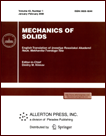 | | Mechanics of Solids
A Journal of Russian Academy of Sciences | | Founded
in January 1966
Issued 6 times a year
Print ISSN 0025-6544
Online ISSN 1934-7936 |
Archive of Issues
| Total articles in the database: | | 13362 |
| In Russian (Èçâ. ÐÀÍ. ÌÒÒ): | | 8178
|
| In English (Mech. Solids): | | 5184 |
|
| << Previous article | Volume 59, Issue 7 / 2024 | Next article >> |
| I.F. Parshina, A.V. Dol’, L.V. Bessonov, A.S. Falkovich, and D.V. Ivanov, "On the Question of the Effect of the Loading Method on the Cancellous Bone Effective Elasticity Modulus," Mech. Solids. 59 (7), 3870-3879 (2024) |
| Year |
2024 |
Volume |
59 |
Number |
7 |
Pages |
3870-3879 |
| DOI |
10.1134/S0025654424606645 |
| Title |
On the Question of the Effect of the Loading Method on the Cancellous Bone Effective Elasticity Modulus |
| Author(s) |
I.F. Parshina (Saratov State University, Saratov, 410012 Russia, abitovaif@rambler.ru)
A.V. Dol’ (Saratov State University, Saratov, 410012 Russia)
L.V. Bessonov (Saratov State University, Saratov, 410012 Russia)
A.S. Falkovich (Saratov State University, Saratov, 410012 Russia)
D.V. Ivanov (Saratov State University, Saratov, 410012 Russia, ivanovdv.84@yandex.ru) |
| Abstract |
Many research groups are studying the strength properties of cancellous bone in uniaxial compression experiments. The effective modulus of elasticity is determined by the linear section of the diagram under the assumption that the specimen is in a uniaxial stress state. Obviously, this is correct only in the case of compression of long specimens, whose length in the direction of load application is significantly greater than the transverse dimensions. Most researchers compress short cubic or cylindrical specimens with an aspect ratio of 2 to 1. It is also noted that under uniaxial compression, tissue in the grip area is damaged, which leads to an underestimation of the calculated effective modulus of elasticity by 20–40%. It is believed that errors in measuring the effective modulus of elasticity can be avoided if the deformation is not measured directly, evaluating only the displacement of the movable crosshead, but a contact or contactless extensometer is used or the ends of the specimens are protected from destruction using end caps. At the first stage of the work, the influence of the relative height of the specimen on the effective modulus of elasticity of the spongy bone of cattle calculated according to the rod theory was studied (a total of 90 bone specimens were tested). At the second stage, the modulus was assessed with direct application of load to the specimen, as well as with gluing plastic and aluminum plugs to its end (a total of 75 bone samples were tested). Regression dependencies were constructed linking the mineral density of the bone and its modulus of elasticity. It was revealed that when the relative height of the specimen is not less than 5 units, it ceases to affect the modulus of elasticity. It was shown that during uniaxial compression of such long specimen, the method of their loading does not affect the modulus of elasticity. It was found that the relationship between the effective modulus of elasticity and mineral density does not depend on the method of loading the specimen, provided that its relative height is not less than 5 units. In this article, a step was made to develop a standard for conducting uniaxial experiments on bone tissue compression aimed at calculating the effective modulus of elasticity. It is shown that when planning such experiments, it is necessary to prepare specimen with a relative height of at least 5 units. This allows for the correct calculation of the effective modulus of elasticity of cancellous bone according to the rod theory, using data on the displacement of the upper grip of the testing machine. |
| Keywords |
effective modulus of elasticity, uniaxial compression, cancellous bone, bone mineral density |
| Received |
15 November 2024 | Revised |
20 November 2024 | Accepted |
22 November 2024 |
| Link to Fulltext |
|
| << Previous article | Volume 59, Issue 7 / 2024 | Next article >> |
|
 If you find a misprint on a webpage, please help us correct it promptly - just highlight and press Ctrl+Enter If you find a misprint on a webpage, please help us correct it promptly - just highlight and press Ctrl+Enter
|
|

 Russian
Russian  English
English